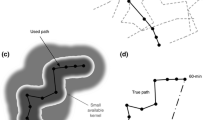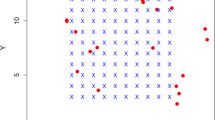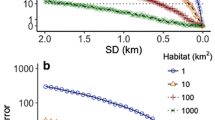Abstract
Spatial Cormack-Jolly-Seber (CJS) models are appealing for analyzing mark-recapture data from electronic tagging studies with fixed receiver arrays due to their ability to accommodate detections on multiple receivers for estimating apparent survival, detection probabilities, individual activity centers, and home range sizes. However, spatial CJS models assume movement and detection processes that may not be met by electronic tagging studies, especially those involving acoustic telemetry technology. To evaluate the sensitivity of spatial CJS models to underlying assumptions, we simulated acoustic telemetry detection histories in a riverine system using two movement processes, one based on movement around activity centers and another using stepwise movement with detections based on an individual’s proximity to a receiver during tag transmission. For each movement process, we evaluated a range of life history and movement parameters and four receiver spacings (configurations) to determine how study design influenced model performance. Simulated detection histories were assessed with spatial CJS models to determine how well model estimates matched known values. When the movement process matched model assumptions, the model performed well across investigated scenarios. However, under a stepwise movement process, convergence was low for all parameters, and variability between activity centers was positively biased. When individuals were undetected for several time steps, activity center estimates tended to drift to gaps in receiver arrays, which could lead to inaccurate conclusions about space use. Decreasing receiver spacing reduced drifting of activity center estimates; therefore, when a stepwise movement behavior is expected, decreasing receiver spacing may improve reliability of activity center estimates.






Similar content being viewed by others

Data availability
All data were simulated for this study, and simulation code is available as supplementary material.
Code availability
Code used to simulate and model the data are available as supplementary material.
References
Adams NS, Beeman JW, Eiler JH (2012) Telemetry techniques: a user guide for fisheries research. American Fisheries Society, Bethesda, MD
Brownscombe JW et al (2019) Conducting and interpreting fish telemetry studies: considerations for researchers and resource managers. Rev Fish Biol Fish. https://doi.org/10.1007/s11160-019-09560-4
Cormack RM (1964) Estimates of survival from the sighting of marked animals. Biometrika 51:429–438
de Valpine P, Turek D, Paciorek CJ, Anderson-Bergman C, Lang DT, Bodik R (2017) Programming with models: writing statistical algorithms for general model structures with NIMBLE. J Comput Graphical Stat 26(2):403–413. https://doi.org/10.1080/10618600.2016.1172487
Dorazio RM, Price M (2019) State-space models to infer movements and behavior of fish detected in a spatial array of acoustic receivers. Can J Fish Aquat Sci 76(4):543–550. https://doi.org/10.1139/cjfas-2018-0067
DuFour MR, Robinson KF, Jones ML, Herbst SJ (2021) A matrix population model to aid agency response to grass carp (Ctenopharyngodon idella) in the Great Lakes Basin - Lake Erie. J Gt Lakes Res 47(1):69–82. https://doi.org/10.1016/j.jglr.2020.06.022
Dupont G, Royle JA, Nawaz MA, Sutherland C (2020) Optimal sampling design for spatial capture-recapture. Ecol:e03262. https://doi.org/10.1002/ecy.3262
Efford MG, Boulanger J, McCrea R (2019) Fast evaluation of study designs for spatially explicit capture–recapture. Methods Ecol Evol 10(9):1529–1535. https://doi.org/10.1111/2041-210x.13239
Gardner B, Reppucci J, Lucherini M, Royle JA (2010) Spatially explicit inference for open populations: estimating demographic parameters from camera-trap studies. Ecol 91(11):3376–3383. https://doi.org/10.1890/09-0804.1
Gardner B, Sollmann R, Kumar NS, Jathanna D, Karanth KU (2018) State space and movement specification in open population spatial capture-recapture models. Ecol Evol 8(20):10336–10344. https://doi.org/10.1002/ece3.4509
Gelman A, Rubin DB (1992) Inference from iterative simulation using multiple sequences. Statist Sci 7(4):457–511
Harris C et al (2021) Movement and space use of grass carp in the Sandusky River, Ohio: implications for Lake Erie eradication efforts. N Am J Fish Manage 41(2):513–530. https://doi.org/10.1002/nafm.10560
Harris C, Brenden TO, Vandergoot CS, Faust MD, Herbst SJ, Krueger CC (2021) Tributary use and large-scale movements of grass carp in Lake Erie. J Gt Lakes Res 47(1):48–58. https://doi.org/10.1016/j.jglr.2019.12.006
Hayden TA, et al. (2016) Probability of acoustic transmitter detections by receiver lines in Lake Huron: results of multi-year field tests and simulations. Animal Biotelemetry 4(1). https://doi.org/10.1186/s40317-016-0112-9
Holbrook C, Hayden T, Binder T, Pye J (2019) glatos: a package for the Great Lakes Acoustic Telemetry Observation System. R package version 0.4.0. https://gitlab.oceantrack.org/GreatLakes/glatos.
Hostetter NJ, Royle JA (2020) Movement-assisted localization from acoustic telemetry data. Mov Ecol 8:15. https://doi.org/10.1186/s40462-020-00199-6
Jolly GM (1965) Explicit estimates from capture-recapture data with both death and immigration stochastic model. Biometrika 52:225–247
Kessel ST et al (2018) Divergent migration within lake sturgeon (Acipenser fulvescens) populations: multiple distinct patterns exist across an unrestricted migration corridor. J Anim Ecol 87(1):259–273. https://doi.org/10.1111/1365-2656.12772
Kraus RT et al (2018) Evaluation of acoustic telemetry grids for determining aquatic animal movement and survival. Methods Ecol Evol 9(6):1489–1502. https://doi.org/10.1111/2041-210x.12996
McClintock BT et al (2021) An integrated path for spatial capture–recapture and animal movement modeling. Ecology 00(00):e03473. https://doi.org/10.1002/ecy.3473
Peterson LK, Jones ML, Brenden TO, Vandergoot CS, Krueger CC (2021) Evaluating methods for estimating mortality from acoustic telemetry data. Can J Fish Aquat Sci. https://doi.org/10.1139/cjfas-2020-0417
R Core Team (2019) R: a language and environment for statistical computing. R Foundation for Statistical Computing, Vienna, Austria
Raabe JK, Gardner B, Hightower JE, Quinn T (2014) A spatial capture–recapture model to estimate fish survival and location from linear continuous monitoring arrays. Can J Fish Aquat Sci 71(1):120–130. https://doi.org/10.1139/cjfas-2013-0198
Royle JA, Chandler RB, Sollmann R, Gardner B (2014) Spatial capture-recapture. Elsevier, Waltham, MA, USA
Seber GA (1965) A note on the multiple-recapture census. Biometrika 52:249–259
Sollmann R, Gardner B, Belant JL (2012) How does spatial study design influence density estimates from spatial capture-recapture models? PLoS One 7(4):e34575. https://doi.org/10.1371/journal.pone.0034575
Sun CC, Fuller AK, Royle JA (2014) Trap configuration and spacing influences parameter estimates in spatial capture-recapture models. PLoS One 9(2):e88025. https://doi.org/10.1371/journal.pone.0088025
Vandergoot CS, Brenden TO (2014) Spatially varying population demographics and fishery characteristics of Lake Erie walleyes inferred from a long-term tag recovery study. Trans Am Fish Soc 143(1):188–204. https://doi.org/10.1080/00028487.2013.837095
Whoriskey K et al (2019) Current and emerging statistical techniques for aquatic telemetry data: a guide to analysing spatially discrete animal detections. Methods Ecol Evol 10(7):935–948. https://doi.org/10.1111/2041-210x.13188
Withers JL, Einhouse D, Clancy M, Davis L, Neuenhoff R, Sweka J (2019) Integrating acoustic telemetry into a mark–recapture model to improve catchability parameters and abundance estimates of lake sturgeon in eastern Lake Erie. N Am J Fish Manage. https://doi.org/10.1002/nafm.10321
Acknowledgements
We thank Andrew Royle and Nathan Hostetter for the technical advice on initial model development and two anonymous reviewers for feedback on the manuscript. Additionally, we thank Charles Belinsky and the Michigan State University High Performance Computing Center and the Institute for Cyber-Enabled Research for the support that made this work possible. This manuscript is contribution 2022-09 of the Michigan State University Quantitative Fisheries Center.
Funding
Funding was provided by the Michigan Department of Natural Resources and supporting partners of the Quantitative Fisheries Center, which includes Michigan State University, Michigan Department of Natural Resources, Great Lakes Fishery Commission, and several Council of Lake Committee fishery management agencies.
Author information
Authors and Affiliations
Contributions
All authors contributed to study conception, study design, study implementation, and manuscript preparation.
Corresponding author
Ethics declarations
Ethics approval
Not applicable.
Consent to participate
Not applicable.
Consent for publication
Not applicable.
Conflict of interest
The authors declare no competing interests.
Additional information
Publisher's note
Springer Nature remains neutral with regard to jurisdictional claims in published maps and institutional affiliations.
Supplementary Information
Below is the link to the electronic supplementary material.
Rights and permissions
About this article
Cite this article
Fischer, J.L., Brenden, T.O. & Nathan, L.R. Influence of study design and movement behavior on performance of open population spatial Cormack-Jolly-Seber models: application to acoustic telemetry technology. Environ Biol Fish 105, 2027–2043 (2022). https://doi.org/10.1007/s10641-022-01276-y
Received:
Accepted:
Published:
Issue Date:
DOI: https://doi.org/10.1007/s10641-022-01276-y



